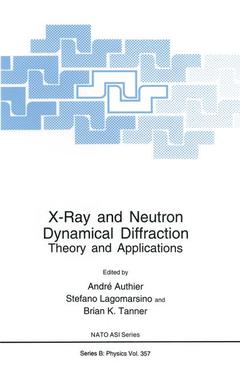Description
X-Ray and Neutron Dynamical Diffraction, 1996
Theory and Applications
NATO Science Series B: Series, Vol. 357
Coordinators: Authier André, Lagomarsino Stefano, Tanner Brian K.
Language: English
Keywords
X-ray; crystal; crystal structure; crystallography; scattering; semiconductor; semiconductors
Publication date: 10-2012
419 p. · 17.8x25.4 cm · Paperback
419 p. · 17.8x25.4 cm · Paperback
Description
/li>Contents
/li>
This volume collects the proceedings of the 23rd International Course of Crystallography, entitled "X-ray and Neutron Dynamical Diffraction, Theory and Applications," which took place in the fascinating setting of Erice in Sicily, Italy. It was run as a NATO Advanced Studies Institute with A. Authier (France) and S. Lagomarsino (Italy) as codirectors, and L. Riva di Sanseverino and P. Spadon (Italy) as local organizers, R. Colella (USA) and B. K. Tanner (UK) being the two other members of the organizing committee. It was attended by about one hundred participants from twenty four different countries. Two basic theories may be used to describe the diffraction of radiation by crystalline matter. The first one, the so-called geometrical, or kinematical theory, is approximate and is applicable to small, highly imperfect crystals. It is used for the determination of crystal structures and describes the diffraction of powders and polycrystalline materials. The other one, the so-called dynamical theory, is applicable to perfect or nearly perfect crystals. For that reason, dynamical diffraction of X-rays and neutrons constitutes the theoretical basis of a great variety of applications such as: ? the techniques used for the characterization of nearly perfect high technology materials, semiconductors, piezoelectric, electrooptic, ferroelectric, magnetic crystals, ? the X-ray optical devices used in all modem applications of Synchrotron Radiation (EXAFS, High Resolution X-ray Diffractometry, magnetic and nuclear resonant scattering, topography, etc. ), and ? X-ray and neutron interferometry.
Dynamical Theory of X-ray Diffraction - I. Perfect Crystals.- Dynamical Theory of Highly Asymmetric X-ray Diffraction.- Dynamical Theory of X-ray Diffraction - II. Deformed Crystals.- Dynamical Theory of Neutron Scattering.- X-ray Optical Beamline Design Principles.- X-ray Polarization and Applications.- Statistical Theory of Dynamical Diffraction in Crystals.- X-ray Diffraction Topography: Principles and Techniques.- Contrast of Defects in X-ray Diffraction Topographs.- X-ray Diffraction Topography: Application to Crystal Growth and Plastic Deformation.- Neutron Topography.- Application of Diffraction Topography to the Study of Magnetic Domains and Phase Transitions.- New Possibilities of Diffraction Topography at Third Generation Synchrotron Radiation Facilities.- X-ray Standing Waves.- X-ray Standing Wave Studies of Bulk Crystals, Thin Films and Interfaces.- X-ray Standing Waves: Thermal Vibration Amplitudes at Surfaces.- Long Period X-ray Standing Waves.- Theoretical Description of Multiple Crystal Arrangements.- Reciprocal Space Mapping.- Superlattices.- Characterization of Lattice Defects in Ion-implanted Silicon.- Multiple Bragg Scattering and the Phase Problem in X-ray Diffraction: Perfect Crystals.- Multiple Bragg Scattering and the Phase Problem in X-ray Diffraction: Mosaic Crystals.- Determination of Reflection Phases by Three-beam Diffraction.- X-ray and Neutron Interferometry: Basic Principles and Applications.- Applications of X-ray Interferometry.- Contributors.
© 2024 LAVOISIER S.A.S.




